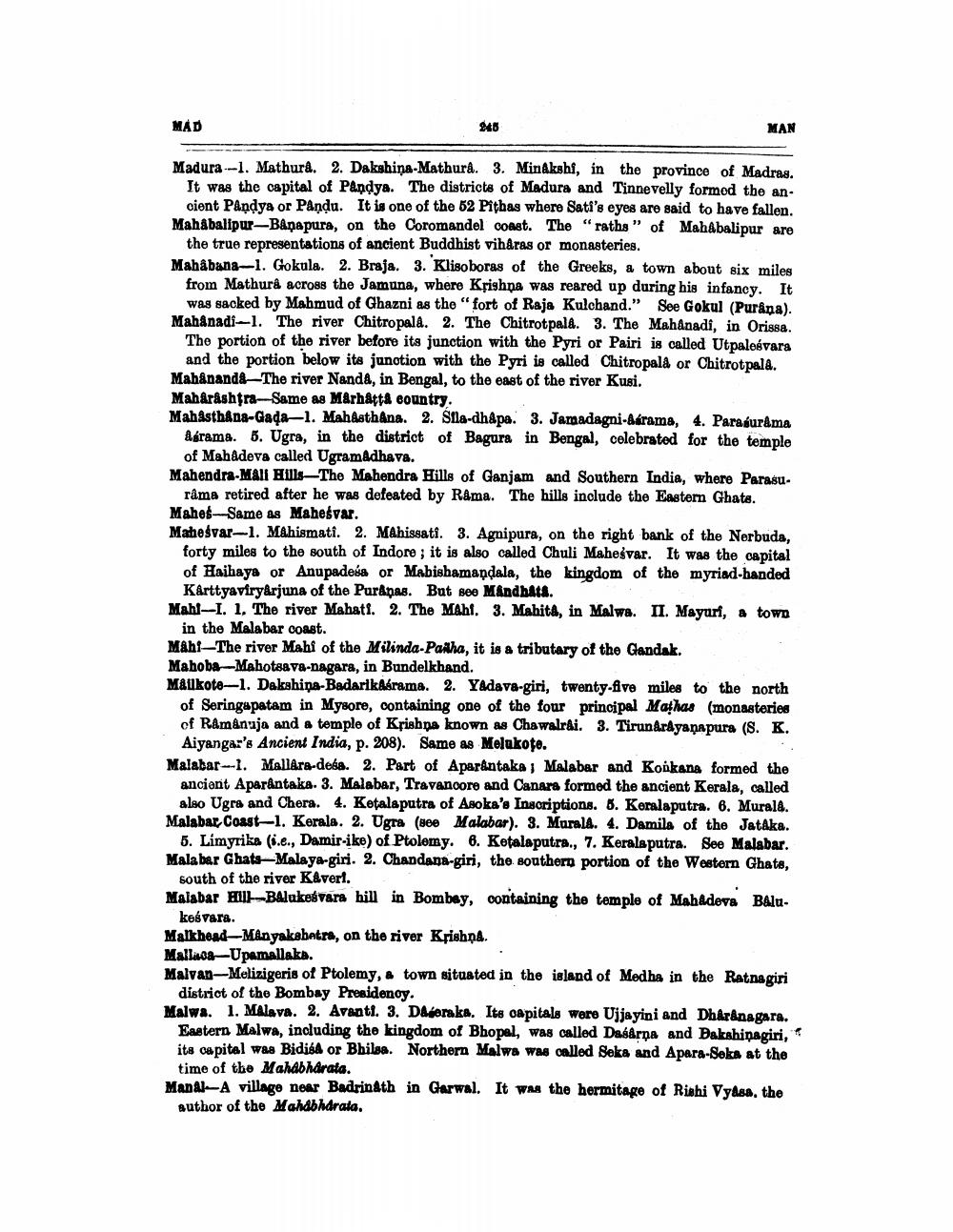________________
MAD
48
MAN
Madura-1. Mathura. 2. Dakshina-Mathura. 3. MinAkshi, in the province of Madras.
It was the capital of Pandya. The districts of Madura and Tinnevelly formod the an
cient Pandya or Pandu. It is one of the 52 Pithas where Sati's eyes are said to have fallen. Mahabalipur-Banapura, on the Coromandel coast. The "raths" of Mahabalipur are
the true representations of ancient Buddhist viharas or monasteries. Mahâbana-1. Gokula. 2. Braja. 3. Kliso boras of the Greeks, a town about six miles
from Mathura across the Jamuna, where Kfishna was reared up during his infancy. It
was sacked by Mahmud of Ghazni as the "fort of Raja Kulchand." See Gokul (Purana). Mahanadi-1. The river Chitropala. 2. The Chitrotpala. 3. The Mahanadi, in Orissa.
The portion of the river before its junction with the Pyri or Pairi is called Utpalesvara
and the portion below its junotion with the Pyri is called Chitropala or Chitrotpala. Mahånand - The river Nanda, in Bengal, to the east of the river Kusi. Maharashtra-Same as Marhatta country. Mahastbana-Gada-1. MahAsthana. 2. Slla-dh&pa. 3. Jamadagni-Asrama, 4. Parasurama
Agrama. 6. Ugra, in the district of Bagura in Bengal, celebrated for the temple
of Mahadeva called Ugramadhava. Mahendra-Mall Hills - The Mahendra Hills of Ganjam and Southern India, where Parasu
râma retired after he was defeated by Rama. The hills include the Eastern Ghats. Mahes-Same as Maheśvar. Mahegyar-1. MAhismati. 2. MAhissati. 3. Agnipura, on the right bank of the Nerbuda,
forty miles to the south of Indore ; it is also called Chuli Mahesvar. It was the capital of Haihaya or Anupadesa or Mabishamandala, the kingdom of the myriad-handed
Karttyaviryarjuna of the Puranas. But see Måndbata. Mahl--I. 1. The river Mahati. 2. The Mahf. 3. Mahita, in Malwa. II. Mayuri, a town
in the Malabar coast. Mahi-The river Mahi of the Milinda-Parha, it is a tributary of the Gandak. Mahoba Mahotsava-nagara, in Bundelkhand. Maukoto-1. Dakshina-Badarik Asrama. 2. Yadava-giri, twenty-five miles to the north
of Seringapatam in Mysore, containing one of the four principal Mathas (monasteries cf Ramanaja and a temple of Krishna known as Chawalrdi. 3. Tirunarayanapura (s. K.
Aiyangar's Ancient India, p. 208). Same as Melukote. Malabar... MallAra-desa. 2. Part of Aparántaka ; Malabar and Konkana formed the
ancient Aparantaka. 3. Malabar, Travancore and Canara formed the ancient Kerala, called
also Ugra and Chera. 4. Ketalaputra of Asoka's Inscriptions. 6. Keralaputra. 6. Murald. Malabar Coast-1. Kerala. 2. Ugra (see Malabar). 3. Marala. 4. Damila of the Jataka.
5. Limyrika (.e., Damir-ike) of Ptolomy. 6. Ketalaputra., 7. Kerals putra. See Malabar Malabar Ghats-Malaya-giri. 2. Chandana-giri, the southern portion of the Western Ghats,
south of the river Kevert. Malabar HUB-Balukesvara hill in Bombay, containing the temple of Mahadeva Balu
kesvara. Malkhead-Manyakabatra, on the river Krishna Mallica-Upamallaka. Malvan-Melizigeris of Ptolemy, a town situated in the island of Medha in the Ratnagiri
district of the Bombay Presidenoy. Malwa. 1. MAlava. 2. Avanti. 3. Dageraka. Its capitals were Ujjayini and Dharanagara.
Eastern Malwa, including the kingdom of Bhopal, was called Dasarņa and Bakshinagiri, its capital was Bidish or Bhilea. Northern Malwa was called Seka and Apara-Seks at the
time of the Mahabharata. Man&—A village near Badrinath in Garwal. It was the hermitage of Rishi Vyasa, the
author of the Mahabharata.




